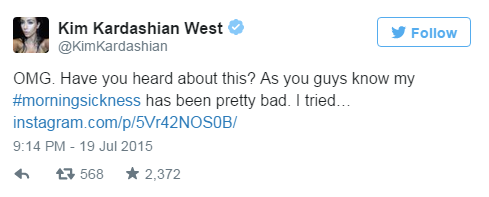Even FDA is Keeping Up With the Kardashians

This week, FDA's Office of Prescription Drug Promotion (OPDP) issued a Warning Letter to Duchesnay, Inc. regarding certain Facebook, Instagram, and Twitter social media posts made by Kim Kardashian about the company's product DICLEGIS, which is indicated for the treatment of nausea and vomiting of pregnancy in women who do not respond to conservative management. While OPDP has reduced its issuance of Warning and Untitled Letters in the past two years,1 this Warning Letter demonstrates the agency's ability to swiftly threaten enforcement action and demand broad corrective action when it has concerns about social media promotion.2 It also demonstrates that OPDP's Bad Ad Program is still in full force, as the violative materials were submitted as a complaint.
OPDP's position, however, is not new. FDA has long held manufacturers responsible for promotional safety or efficacy claims made by an agent or third party acting on the manufacturer's behalf, about that manufacturer's products. In 2008, for example, FDA issued a Warning Letter to a manufacturer based on a YouTube video and related endorsements by celebrity Ty Pennington.3 Nevertheless, given the tremendous amount of social media activity that manufacturers, patients, and related stakeholders engage in, the Kardashian Warning Letter signifies FDA's continued commitment to monitor and cite manufacturers and their agents for advertising and promotional practices using interactive promotional media. The Warning Letter also comes roughly 1.5 years after FDA issued its first social media guidance, which the agency subsequently followed with two additional draft social media guidance documents.4
Drug manufacturers, advertising and promotion agencies, and celebrities alike should carefully evaluate the Kardashian Warning Letter and the associated interactive promotional materials to avoid potential FDA enforcement action and develop appropriate compliance policies and guidelines. FDA has increasingly cited promotional claims used to market products on Facebook, including seven (7) enforcement letters between October 2014 and February 2015.5 And prior to these letters, FDA cited at least two companies for a "Like" on Facebook regarding improper promotional claims.6 Thus, companies should revisit their social media and promotional review committee policies and procedures to ensure that interactive promotional materials and communications are properly vetted before use or dissemination.
FDA's Social Media Guidance
The Federal Food, Drug, and Cosmetic Act (FDCA) grants FDA the authority to oversee the labeling of drugs and medical devices and advertising of prescription drugs and restricted medical devices.7 FDA generally recognizes two types of labeling for drugs: (1) FDA-required labeling (e.g., the prescribing information or PI); and (2) promotional labeling. Generally, FDA regulations require promotional labeling or materials - regardless of medium - to present certain risk information (e.g., warnings, precautions, side effects, contraindications, etc.) in a "fair and balanced" manner. According to FDA's broad interpretation of the law, promotional labeling is generally any labeling, other than the FDA-required labeling, that is devised and distributed for promotion of a product. In FDA's view, this may include product websites, blogs, chatrooms, social media pages, or other interactive promotional media devised by a manufacturer or their agents for promotion of an FDA-regulated product.
In January 2014, FDA issued its first true draft social media-focused guidance, entitled "Draft Guidance for Industry: Fulfilling Regulatory Requirements for Postmarketing Submissions of Interactive Promotional Media for Prescription Human and Animal Drugs and Biologics."8 The Draft Guidance: (1) describes FDA's current thinking on what the Agency considers to be interactive promotional media; (2) outlines the considerations taken into account in determining if product communications using interactive technologies are subject to FDA's postmarketing submission requirements; and (3) makes recommendations for how firms can fulfill the regulatory requirement to submit postmarketing promotional materials to the FDA in a practical manner to address the potential volume of real-time information that is continuously posted and shared through various interactive promotional media platforms.
Specifically, the Draft Guidance states that firms are responsible for submitting postmarketing information if they "own, control, create, influence, or operate" the interactive promotional media platform.9 In fact, FDA emphasizes that a firm is responsible for promotion both on sites that it owns or controls and third-party sites if the firm "exerts influence over a site in any particular, even if the influence is limited in scope," such as "collaborat[ing] on or ha[ving] editorial, preview, or review privilege over the content provided."10
FDA also explained that firms are responsible for content generated by an employee or agent who is acting on behalf of the firm to promote the firm's product.11 This position is consistent with a 2011 FDA Untitled Letter that cited a YouTube video, posted by a Warner Chilcott sales representative, for being misleading, failing to disclose the drugs indication, failing to present risk information, and omitting material facts.12 However, in an important acknowledgement by FDA, the Draft Guidance states that firms are "generally not responsible for [user generated content] (UGC) that is truly independent of the firm (i.e., is not produced by, or on behalf of, or prompted by the firm in any particular).13
The Duchesnay/Kardashian Warning Letter
According to FDA's Warning Letter, Duchesnay submitted the social media posts to OPDP under cover of Form FDA 2253.14 Almost immediately, OPDP asserted that the posts were false and misleading because they presented efficacy claims for DICLEGIS, but failed to communicate any risk information associated with its use and the posts omitted material facts. OPDP maintained that the social media posts not only misbranded DICLEGIS, but also raise serious concerns from "a public health perspective because they suggest that DICLEGIS is safer than has been demonstrated." OPDP expressed even greater concern that Duchesnay is "continuing to promote DICLEGIS in a violative manner" because OPDP had previously issued an Untitled Letter to the company in November 2013 regarding a letter announcing the approval of DICLEGIS.15" target="_blank">letter announcing DICLEGIS' approval, omitted all risk information and omitted material facts regarding DICLEGIS' important limitation of use.]] OPDP first took issue with the fact that Ms. Kardashian's post "entirely omits all risk information," thereby suggesting that DICLEGIS was "safer than has been demonstrated." Although not explicitly stated by OPDP, Ms. Kardashian's posts claim that she is "partnering with Duchesnay USA to raise awareness about treating morning sickness." Thus, OPDP concluded that Ms. Kardashian was acting as an agent and/or on behalf of Duchesnay in publishing the social media posts.16 Consistent with FDA's Draft Guidance, OPDP held Duchesnay responsible for Ms. Kardashian's posts because she was an agent acting on behalf of the company to promote DICLEGIS (e.g., a "paid speaker … acting on the firm's behalf [who] comments on a third-party site about the firm's product").17
Moreover, while the social media posts included hyperlinks to the DICLEGIS product website and safety information, FDA reasoned that the links did "not mitigate the misleading omission of risk information." Interestingly, it appears that two of Ms. Kardashian's social media posts were not space or character limited (Facebook and Instagram). Thus, she and/or Duchesnay could have included the necessary risk information or even taken advantage of FDA's recommendations in its Internet/Social Media Platforms with Character Space Limitations draft guidance.
OPDP also maintained that the social media posts were misleading because they failed to provide material information regarding DICLEGIS' full approved indication, including important limitations of use. Specifically, the posts failed to convey that DICLEGIS had not been studied in women with hyperemesis gravidarum.18
Consequently, OPDP requested that Duchesnay immediately cease these promotional activities and submit a written response to OPDP on or before August 21, 2015. OPDP specifically asked the company to list all promotional materials (with the 2253 submission date) for DICLEGIS that contain presentations such as those described above, and explain its plan for discontinuing use of such materials, or, in the alternative, for ceasing distribution of DICLEGIS. Because OPDP found the violations to be "serious and repeated," it also required that Duchesnay "include a comprehensive plan of action to disseminate truthful, non-misleading, and complete corrective messages about the issues discussed in this letter to the audience(s) that received the violative promotional materials."
OPDP recommended that corrective piece(s): (1) include a description of the violative promotional piece(s) and/or activity; (2) include a summary of the violative message(s); (3) provide information to correct each of the violative message(s); and (4) be free of promotional claims and presentations. To the extent possible, OPDP asked that the corrective messaging "be distributed using the same media, and generally for the same duration of time and with the same frequency that the violative promotional material was disseminated." In other words, it is possible that Duchesnay and Ms. Kardashian will need to issue corrective Facebook, Instagram, and Twitter posts.
Duchesnay responded to media outlets that it would take "quick action" and acknowledged its responsibility to ensure that "its communications, including in social media" need to comply with applicable rules and regulations.19
Conclusion
The Kardashian Warning Letter provides a number of important lessons for drug manufacturers and related stakeholders to consider. First, the Warning Letter demonstrates OPDP's focus on companies that engage in repeated violations (omission of all risk information) and have prior enforcement actions. Second, the Warning Letter demonstrates OPDP's continued commitment to focus on newly launched products with wide-ranging promotional campaigns--in this case, the use of Ms. Kardashian as a company spokesperson. For instance, after initial publication on or about July 19, 2015, her social media post had over 464,000 likes and almost 11,000 comments; her post on Twitter had almost 600 re-tweets and over 2,300 favorites. Ms. Kardashian's prominence, coupled with Duchesnay's repeated violations and the potential public health risk for pregnant women (and unborn children) almost certainly made this enforcement action one of OPDP's fastest in history. Third, the letter highlights continuing concerns and lack of clarity regarding the use of links as a means of providing required warnings and safety information.
Fourth, the Kardashian Warning Letter demonstrates the importance of having clear company policies, procedures, and processes for working with outside spokespeople. Some media outlets suggest that Ms. Kardashian was a paid spokesperson only for these posts, while others--including Ms. Kardashian herself--suggest that there was a larger collaboration or "partnership." As noted above, FDA has long held that manufacturers are responsible for statements or communications made by agents acting on behalf of a manufacturer. Ambiguity in the scope of those agency relationships can lead to significant execution risks for manufacturers, particularly where public figures make endorsements of a manufacturer or its products in media that are not easily subjected to manufacturer pre-review. Thus, companies should ensure robust agreements and processes are in place to delineate when outside individuals--especially prominent celebrities or public figures--are agents permitted to speak about the company's product, in what media those communications may be made, and how their activities will be managed to ensure compliance.
Such processes should ensure that contracts or agreements address use of social media or other platforms to discuss the company's product, as well as a requirement that the spokesperson receive FDA- and FTC-related training. It should also be clear that company spokespeople can only post content that the company has reviewed and approved prior to publication. And the company's promotional review committee or related body should have clear guidance and instruction on how to review, modify, and approve such content, accounting for applicable character space limitations, fair balance, and other factors outlined in applicable FDA regulations and guidance, particularly with respect to postmarket submissions to OPDP.
Finally, manufacturers should consider implementing systems or programs to monitor company spokespeople or other social media content to identify, correct, or remove any potentially violative content. While this may require additional resources, adequate oversight might have allowed Duchesnay to edit or remove the content once the company could have recognized the social media post was promotional and omitted all risk information. And although use of celebrities may be valuable to promotional campaigns, such efforts must be weighed against the risks of negative publicity and confusion created by FDA Warning Letters.
In the end, while some may continue to keep up with the Kardashians, manufacturers should revisit their social media, endorsement, and testimonial policies, and review processes to avoid potential enforcement action.
-
For example, in 2013 and 2014, OPDP issued only 22 and 10 enforcement letters respectively, a decrease from 28 and 31 letters in 2012 and 2011. See FDA, Warning Letters and Notice of Violation Letters to Pharmaceutical Companies.
-
Ms. Kardashian published the social media posts on or around July 19, 2015; OPDP appears to have accessed the applicable Facebook and Instagram posts only 4 days before issuing the Warning Letter.
-
FDA, Warning Letter to Shire (Sept. 25, 2008).
-
See Arnold & Porter Advisory, "FDA's New Online Media Draft Guidance Documents." The FTC also maintains separate but complementary rules governing product endorsements and testimonials to ensure, for example, that material information is disclosed (including ties between the endorser and a manufacturer) and that the experience described by a product user would exemplify a typical patient experience. See, e.g., 16 C.F.R. § 255 (Guides Concerning the Use of Endorsements and Testimonials in Advertising).
-
See e.g., Vitalab Co., Inc. (Oct. 16, 2014); Bodyhealth.com (Nov. 18, 2014); Canna Companion LLC (Feb. 24, 2015); Institut Biochimique SA & Akrimax Pharm., LLC (Feb. 24, 2014); NanoBiotech Pharma (Feb. 26, 2015); cancerherbtea.com (Feb. 26, 2015); and CBD Life Holdings LLC dba Ultra CBD (Feb. 26, 2015). OPDP also has recently cited manufacturer use of Twitter (Oasis Consumer Healthcare, LLC (Feb. 11, 2013)) and YouTube (Big Mountain Drugs (Feb. 4, 2013)).
-
See AMARC Enterprises, Inc. (Dec. 11, 2012) and Zarbee's, Inc. (Jun. 27, 2014). OPDP has also cited at least one manufacturer for a "Facebook Share" widget. See Novartis Pharm. Corp. (Jul. 29, 2010).
-
The Federal Trade Commission (FTC) has jurisdiction of advertising of non-restricted medical devices.
-
FDA, Draft Guidance for Industry: Fulfilling Regulatory Requirements for Postmarketing Submissions of Interactive Promotional Media for Prescription Human and Animal Drugs and Biologics (Jan. 2014) (hereafter "FDA Postmarketing Interactive Promotional Media Guidance").
-
Id. at 3-4. This would include product websites, discussion boards, chat rooms, or other public electronic forums that a firm uses to promote its products, which the firm maintains, and over which it has full control. FDA further explained that firms would be responsible for product promotional communications if the firm exert influence over a site in "any particular, even if the influence is limited in scope," such as content collaboration, "preview, or review privilege over the content." Id.
-
-
-
FDA, Untitled Letter to Mr. Brian Deutsch, Associate, Regulatory Affairs, Warner Chilcott (US), LLC (May 2, 2011).
-
Id. at 5 (citing 47 U.S.C. § 230(c)(1) ("no provider or user of an interactive computer service shall be treated as the publisher or speaker of any information provided by another information content provider"). The Communications Decency Act further defines "information content provider" as someone "responsible, in whole or in part, for the creation or development of information provided through the Internet or any other interactive computer service." 47 U.S.C. § 230(f )(3).
-
The social media posts were as follows: OMG. Have you heard about this? As you guys know my #morningsickness has been pretty bad. I tried changing things about my lifestyle, like my diet, but nothing helped, so I talked to my doctor. He prescribed me #Diclegis, and I felt a lot better and most importantly, it's been studied and there was no increased risk to the baby. I'm so excited and happy with my results that I'm partnering with Duchesnay USA to raise awareness about treating morning sickness. If you have morning sickness, be safe and sure to ask your doctor about the pill with the pregnant woman on it and find out more ww.diclegis.com; www.DiclegisImportantSafetyInfo.com.
-
Similar to the social media posts, the 2013 promotional material, which was a
-
However, at least one media outlet reported that Duchesnay and Ms. Kardashian's "partnership did not go beyond the initial post" to social media. See "Kim Kardashian Instagram post gets drugmaker in trouble," CNN Money (Aug. 11, 2015).
-
FDA Postmarketing Interactive Promotional Media Guidance at 4.
-
A pregnancy condition that can lead to nausea, vomiting, dehydration, and even drowsiness.
-



